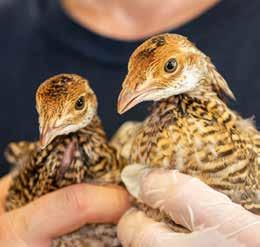
3 minute read
Wildlife Conservation at the Zoo
SAVING ANIMALS IN THE WILD:
Because of on-grounds recycling efforts, we diverted 2,605 cubic yards of waste headed to landfills and avoided 18 metric tons of greenhouse gas emissions.
Saving Wild Birds at the Zoo
Millions of migratory birds soar across Texas every year, so the Zoo works hard to maintain a bird-safe environment. Special bird-safe window treatments have been installed on buildings and exhibits, on Zoo grounds, to protect wild birds from window collisions. You can see the bird-safe glass on the Cypress Circle Café, in front of the Texas Wetlands which offers a safe rest and recouperation stop for many wild birds that pass through on their migratory journeys. In 2021, our Zoo Crew teen program created a bird monitoring team to track some of the wild bird activity on Zoo grounds.
Bird-Friendly coffees are grown in a way that provides a variety of foods for birds. Unlike the shade-grown coffee designation, Bird-Friendly coffee ensures that coffee farms provide vegetation cover that protects high quality habitat for birds and other wildlife. In 2021, the Zoo worked with its coffee roaster, Katz Coffee, on getting their Smithsonian Bird Friendly coffee certification. When you drink the coffee at the Zoo you can know that you are helping to save thousands of wild birds and many of the bird species we have at the Zoo, like the Andean cock-of-the-rock, in the wild.

Striped bird-safe window treatments
installed at Cypress Circle Café

Saving Animals by Saving Water
The Houston Zoo continued to reduce its water use as part of an effort to conserve natural resources and protect wildlife. Even as new exhibits and facilities opened and post-pandemic attendance numbers continued to increase, the Zoo still reduced its overall water consumption by nearly 13 million gallons between 2020 and 2021. The Zoo has reduced its water consumption every year since 2017 through water-saving measures like rainwater collection and reuse, better leak detection, more efficient landscape irrigation, and the upgrading of older exhibits and buildings to newer water-efficient systems.
These efforts help conserve water as a precious resource for both humans and animals. The extraction and treatment of water requires the use of energy that is largely supplied by fossil fuels, and it can deplete aquifers and contribute to the loss of aquatic habitats such as lakes, rivers, and wetlands. Saving water is one of the critical ways in which the Zoo helps ensure its operations protect animals in the wild.

Cutting Emissions and Protecting Animals through Recycling
In 2021, the Houston Zoo’s efforts to keep waste out of landfills helped preserve natural habitats and cut carbon emissions. The Zoo recycled more than 62 tons of cardboard, and plastics as well as as 31 tons of metal. Combined with more than 1,186 tons of composted organic material, these efforts avoided 2,605 cubic yards of space that these materials would have taken up in local landfills. The Zoo’s recycling efforts included more than 1,040 lbs of office electronics like computers, monitors, and printers, as well as 1,137 cell phones, tablets, and small electronic gadgets collected from the local community. Cell phones and tablets contain precious metals that are mined in gorilla habitats, so by extending the life of metals that have already been extracted, it reduces the demand for newly mined metals and saves gorillas in the wild.
These efforts to keep waste out of landfills also helped eliminate carbon emissions. Roughly 18 metric tons of greenhouse gas emissions were avoided by recycling or composting these materials rather than allowing them to break down in a landfill.









